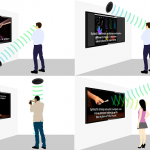Directional Sound refers to the notion of using various devices to create fields of sound which spread less than most (small) traditional loudspeakers. Several techniques are available to accomplish this, and each has its benefits and drawbacks. Ultimately, choosing a directional sound device depends greatly on the environment in which it is deployed as well as the content that will be reproduced. Keeping these factors in mind will yield the best results through any evaluation of directional sound technologies.
The directional speaker radiates sound in one direction only – as opposed to conventional speakers, which spread the sound into all directions. Directional speaker acts like an audio spotlight and allows you to create your personal audio zone or enable different audio zones to co-exist in the same physical space, while preventing the different acoustic contents from mixing and interfering. The audio beam created by directional speaker can cut through noisy environments and deliver a headphone-like experience for the listener.
Applications
• Retail
• Digital signage
• Museum and gallery installations
• Fairs and trade shows
• Info-points
• Libraries
• Automotive applications
• Slot machines
• Mobile applications
• Custom applications
Spotlight mode
In case the Acouspade directional speaker is mounted on the same wall – on top or bellow the digital sign, it needs to point diagonally downwards or upwards respectively, in order for the audio beam to reach all possible heights of users. In this mode the sound can not always be heard at the exact same spot, since the listening spot will depend on the users height. In case of a digital-signage situation this should not be a problem since the listening spot will always be in front of the digital screen, but the distance of the sweet-spot from the screen will be determined by the person’s height and will vary within 1 to 2 meters. This mounting mode will also create more audible artifacts around the room, since the first surface (floor or ceiling) will be hit in a specific angle, which will reflect the sound to the next surface, and so on.
Sound shower mode
Ideally, the Acouspade directional speaker should be mounted on the ceiling, facing the floor. This creates a typical “sound-shower” situation, making the sound audible only at one spot in the room, while enabling it to be heard by people – of all heights – at the same spot. The sound-shower mode is also the best solution to minimize reflections of the sound and its audibility at different locations around the room. The sound starts to travel from the ceiling, bounces off the floor and is reflected back to the same spot at the ceiling, and so on.
Virtual speaker mode
A very interesting mounting situation is the “Virtual speaker mode”, where the speaker is not pointing directly towards the user. Instead, the speaker is pointing towards the digital sign, (or any other object that you want to draw attention to, by using directional sound) from which the sound beam bounces and arrives at the user indirectly. This situation makes it appear as if the sound originates from the object that it is being reflected from. The actual sound source remains hidden and is not noticed by the user.
Solutions for Museums
Museums and exhibition sites often have several different themes or works within the same area. Therefore, the installation is often acoustically very challenging, forcing museums to provide headsets for visitors to guide them through the site.

